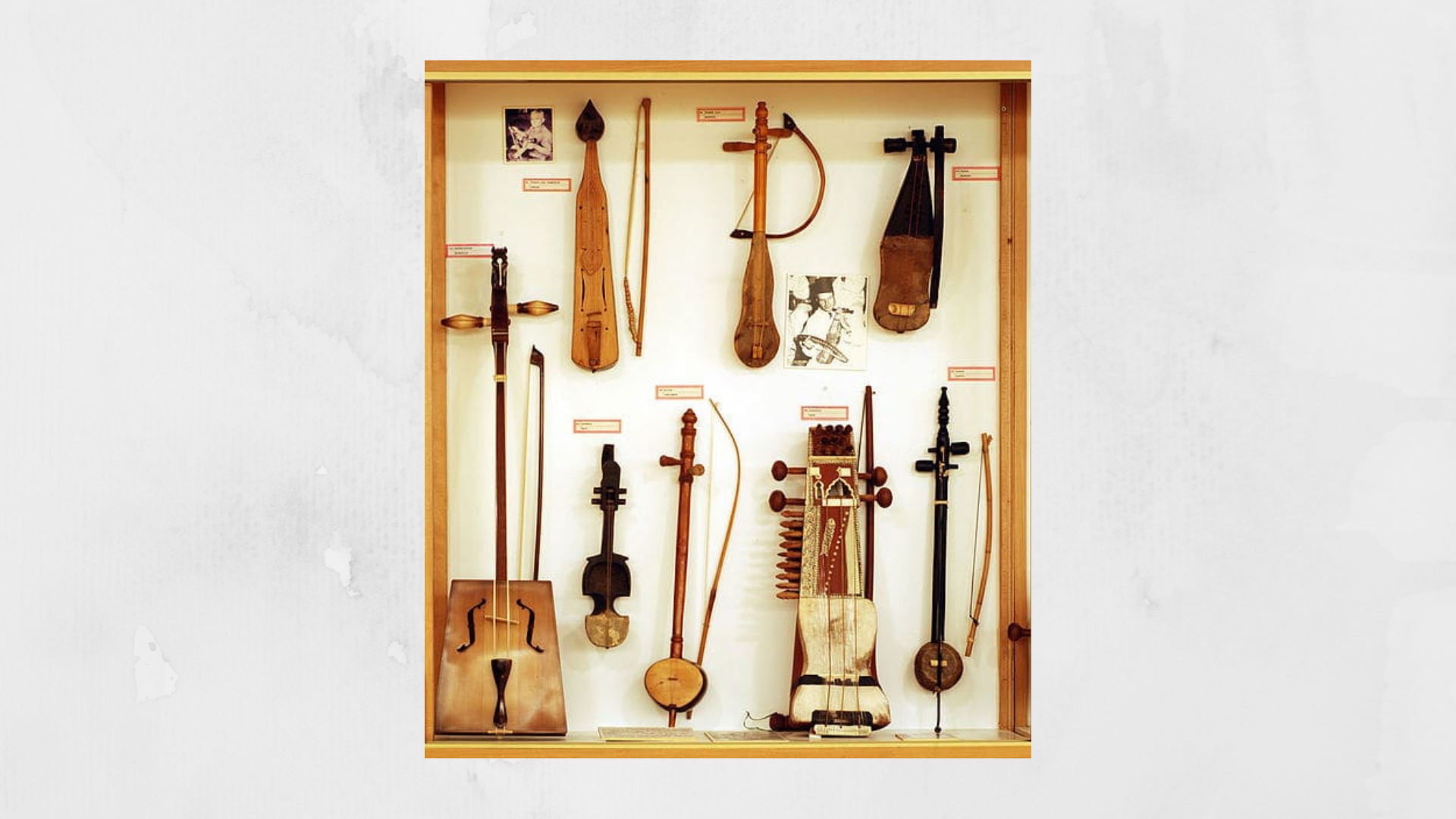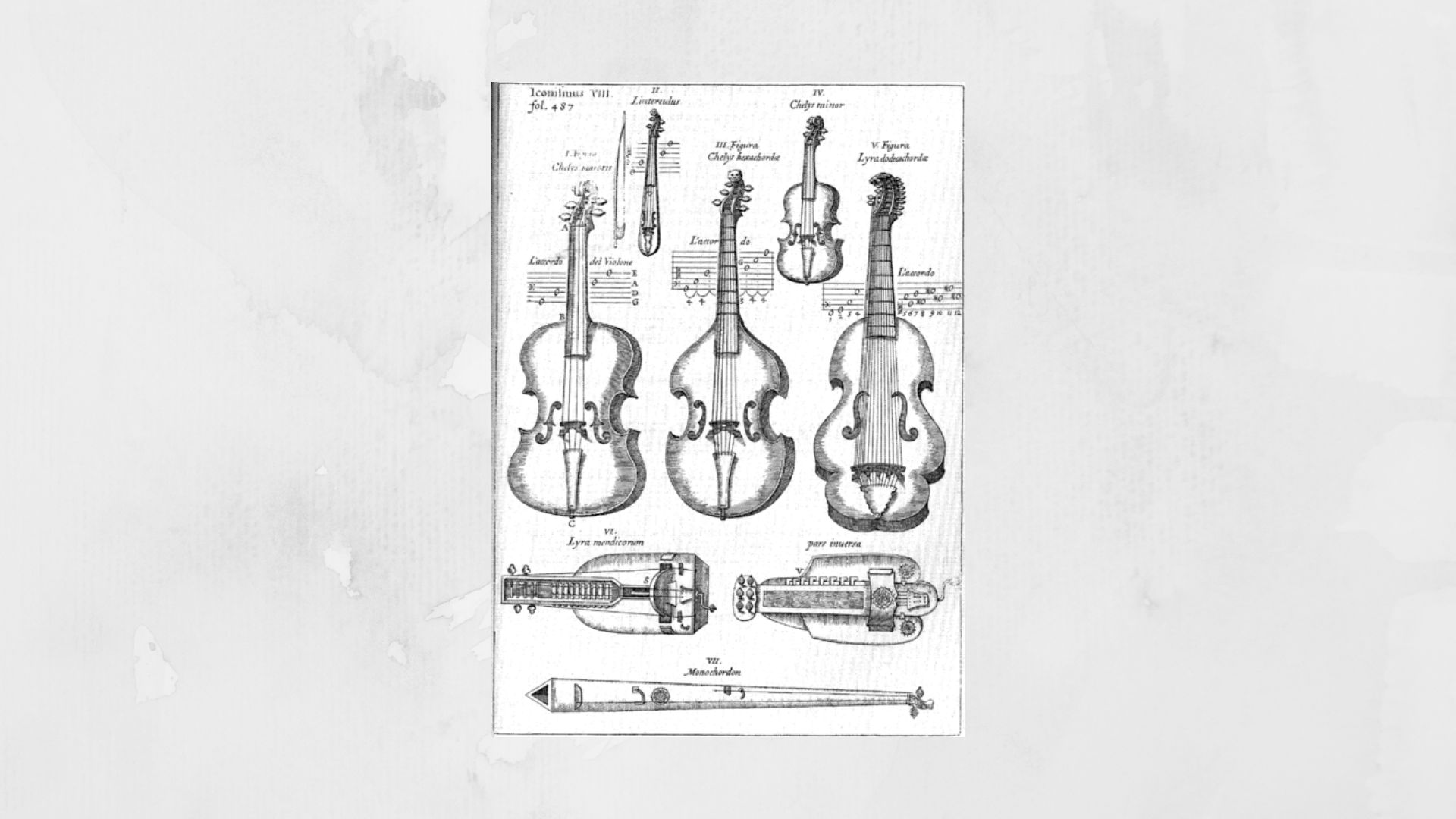The most up-to-date version of this article can be found here - please click here!
Bowed string instruments have been played all over the world for many thousands of years.
Medieval instruments including the Chinese erhu, the Finnish bowed lyre and the Indian sarangi all had the same basic mechanics as the modern violin, using the principle of a continually resonating string amplified by a hollow body.
In 7th century Greece, there was an instrument called the kithara, a seven stringed lyre, the features of which were very different from the violin.
Early Origins
The development of a musical instrument is rather like the process of evolution. It is gradual and complex, with many of its stages indistinct or undocumented. The history of the violin can be traced back more or less to the 9th century.

One plausible ancestor for the violin is the rabãb, an ancient Persian fiddle which was common in Islamic empires. The rabãb had two strings made of silk which were attached to an endpin and tuning pegs.
These strings were tuned in fifths. The instrument was fretless, its body made from a pear shaped gourd and a long neck.
It was introduced to Western Europe in the 11th and 12th centuries, and the influence of both the rabãb and lyre, along with a constant search for perfection and refinement and the demands of increasingly complex repertoire, led to the development of various European bowed instruments.
Ancestors of the Violin
Forerunners of the violin include the rebec, an instrument based on the rabãb, which appeared in Spain, most likely as a result of the Crusades.
The rebec had three strings and a wooden body and was played by resting it on the shoulder.
There were also Polish fiddles, the Bulgarian gadulka and Russian instruments called gudok and smyk, which are portrayed in frescos from the 11th century.
The 13th century French vielle was very different from the rebec. It had five strings and a larger body, which was closer in shape and size to the modern violin, with ribs shaped to allow for easier bowing.
Confusingly, the name vielle later came to refer to a different instrument, the vielle á rue, which we know as the hurdy-gurdy.
Emergence and Early Variants
There is no reference to the word violin until the reign of Henry VIII, but something very much like the violin existed, and its name was fydyl.
This instrument was played with a fydylstyck, proof that it was bowed and not plucked.
It had only three strings and a fretless fingerboard, and it was used for dancing, in banquets and social events; occasions which required an instrument with a strong sound, held shoulder height for projection.
In 15th century Italy, two distinct kinds of bowed instruments emerged. One was fairly square in shape and held in the arms and was called a lira da braccio or viola da braccio, meaning viol of the arm.
This instrument had three strings and was the same general size and shape as the vielle, but the C-shaped sound holes in the body had been replaced by the now familiar F-holes.
The other bowed instrument was a viola da gamba, meaning viol for the leg.

The Rise of the Modern Violin
These gambas were important instruments during the Renaissance period, but were gradually replaced by the louder instruments of the less aristocratic lira da braccio family as the modern violin developed.
The violin first appeared in the Brescia area of Northern Italy in the early sixteenth century.
From around 1485, Brescia was home to a school of highly prized string players and famous for makers of all the string instruments of the Renaissance; the viola da gamba, violone, lyra, lyrone, violetta and viola da brazzo.
The word violin appears in Brescian documents for the first time in 1530, and whilst no instruments from the first decades of the fifteenth century survive, violins are shown in several paintings from the period.
Violins vs Viols
The first clear description of the violin, depicting its fretless appearance and tuning, was in the 1556 Epitome Musicale by Jambe de Fer.
By this time the violin had begun to spread throughout Europe. It was mainly used to perform dance music but was introduced into the upper classes as an ensemble instrument.
Where the viol, which was preferred in aristocratic circles, had been perfect for contrapuntal music and for accompanying the voice, the violin was normally played by professional musicians, servants and illiterate folk musicians.
| "The violin is very different from the viol. First, it has only four strings, which are tuned at a fifth from one to the other, and each of the said strings has four pitches in such wise that on four strings it has just as many pitches as the viol has on five.
It is smaller and flatter in form and very much harsher in sound, and it has no frets because the fingers almost touch each other from tone to tone in all the parts. Why do you call the former Viols, the latter Violins? We call viols those upon which gentlemen, merchants, and other persons of culture pass their time.The Italians call them "viole da gambe,” because they hold them at the bottom, some between the legs, others upon some seat or stool; others [support them] right on the knees of the said Italians, [but] the French make very little use of this method. The other kind [of instrument] is called "violin", and it is this that is commonly used for dance music [dancerie], and for good reason: for it is easier to tune, because the fifth is sweeter to the ear than the fourth is" It is, also easier to carry, which is a very necessary thing, especially in accompanying some wedding or mummery. The Italian calls it "violon da braccia" or "violone" because it is held upon the arms, some with a scarf, cord, or other thing. I did not put the said violin in a diagram, for you can consider it upon [the one for] the viol, joined [to the fact] that few persons are found who make use of it other than those who, by their labour on it, make their living." - Jambe de Fer from the Journal of the Viola Da Gamba Society of America, November 1967. |
The Evolution of the Modern Violin
The viola and cello developed alongside the violin in early 16th century Italy. This new family of stringed instruments gradually took the place of the gambas and viols as new ideas of sound emerged.
It is commonly accepted that the first modern violin was built by Andrea Amati, one of the famous luthiers (lute makers) of Cremona, in the first half of the 16th century.
The first four-stringed violin by Amati was dated 1555 and the oldest surviving of his instruments is from around 1560, but between 1542 and 1546, Amati also made several three-stringed violins.
Amati built his violins using a mould, which meant the measurements became much more precise. He developed a more vaulted shape for the body of the instrument rather than the flat soundboards of the early stringed instruments.
It is speculated that Amati may have studied with Gesparo da Salo in Brescia, but some records show that he was well established in Cremona long before he began making violins, and was in fact older than da Salo.
The Brescian school of luthiers had existed for 50 years before violin making began in Cremona, but the Cremona school gained prominence after 1630, when the bubonic plague swept Northern Italy and eliminated much of the Brescian competition.
Italy had managed to avoid the thirty-year war and development of the instrument continued in a golden age of culture.
Andrea Amati mastered many apprentices, and produced a dynasty of violinmakers, including the Guarneris, Bergonzis, and Rugeris.
His own sons followed him into the trade, and his grandson, Nicoló Amati, the most famous Amati, trained Antonio Stradivarius.
Stradivarius made over 100 instruments, of which roughly two thirds survive. His violins are some of the most imitated by modern makers today.
18th and 19th Century Transformations
The violin, originally an instrument of the lower classes, continued to gain popularity, becoming integral in the orchestra during the seventeenth century as composers such as Monteverdi began writing for the new string family.
The instrument continued to develop between the sixteenth and nineteenth centuries, and the surviving historic violins have all undergone alterations.
The violin bow changed dramatically in around 1786, when Françoise Xavier Tourte invented the modern violin bow by changing the bend to arch backwards and standardising the length and weight.
The violin fingerboard was lengthened in the 19th century, to enable the violinist to be able to play the highest notes. The fingerboard was also tilted to allow more volume.
The neck of the modern violin was lengthened by one centimetre to accommodate the raising of pitch in the 19th century and the bass bar was made heavier to allow for greater string tension.
Where classical luthiers would fix the neck to the instrument by nailing and gluing it to the upper block of the body before attaching the soundboard, the neck of the modern violin is mortised to the body once it is completely assembled.
By the 18th and 19th century the violin had become extremely popular. By the late 18th century, makers had begun to use varnished developed to dry more quickly.
This had an impact on the quality of instruments produced. The quality of the wood used in violin making has been affected by the lack of purity of modern water as nearly all substances dissolved in water permanently penetrate wood.
By the 19th century violins were being mass-produced all over Europe. Millions were made in France, Saxony and the Mittenwald, in what is now Germany, Austria, Italy and Bohemia, now part of the Czech Republic.
It is partly for this reason that the violins of the early Italian masters are so prized, so well regarded and so expensive. A Stradivarius violin will now sell for many millions, the most expensive so far on record sold for $16million in 2011.
Modern Violins
More recently, new violins were invented for modern use. The Romanian Stroh violin used amplification like that of a gramophone to boost the volume.
In the late 19th and early 20th centuries, before electronic amplification became common, these violins with trumpet-like bells were used in the recording studio where a violin with a directional horn suited the demands of early recording technology better than a traditional acoustic instrument.
Electric and electro-acoustic violins have also been developed. An electro-acoustic violin may be played with or without amplification, but a solid bodied electric violin makes little or no sound without electronic sound reinforcement.
Electric violins can have as many as seven strings and can be used with equalisers and even sound effects pedals, a far cry from the exacting acoustic knowledge which created the great violins of the Italian Renaissance.
Please visit our sponsors:
London String School - Tuition for Adult Learners in London
MusicLand - Creative Music Products for Teachers and Learners
Please visit our sponsors:
FiddlerShop.com - Quality instruments at an affordable price
London String School - Tuition for Adult Learners in London
MusicLand - Creative Music Products for Teachers and Learners
